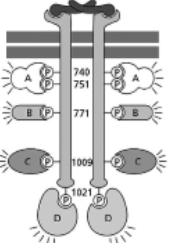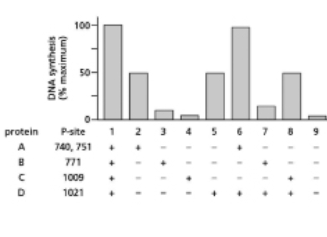When activated by the extracellular signal protein platelet-derived growth factor (PDGF), the PDGF receptor phosphorylates itself on multiple tyrosines (as indicated in Figure 16-61A by the circled Ps; the numbers next to these Ps indicate the amino acid number of the tyrosine).These phosphorylated tyrosines serve as docking sites for proteins that interact with the activated PDGF receptor.These proteins are indicated in the figure, and include the proteins A, B, C, and D.One of the cell's responses to PDGF is an increase in DNA synthesis, which can be measured by the incorporation of radioactive thymidine into the DNA.
To determine which protein or proteins-A, B, C, or D-are responsible for the activation of DNA synthesis, you construct mutant versions of the PDGF receptor that retain one or more tyrosine phosphorylation sites.You express these mutant versions in cells that do not make their own PDGF receptor.In these cells, the various mutant versions of the PDGF receptor are expressed normally, and, in response to PDGF binding, become phosphorylated on whichever tyrosines remain.You measure the level of DNA synthesis in cells that express the various mutant receptors and obtain the data shown in Figure 16-22B. (A)
(B)
Figure 16-22
A.From these data, which, if any, of proteins A, B, C, and D are involved in the stimulation of DNA synthesis by PDGF? Explain your answer.
B.Which, if any, of these proteins inhibit DNA synthesis? Explain your answer.
C.Which, if any, of these proteins seem to have no detectable role in DNA synthesis? Explain your answer.
Definitions:
Uses of Cash
The various ways in which a company or individual allocates cash resources, including operating expenses, investments, and financing activities.
Fixed Assets
Durable physical assets utilized in the running of a company, which aren't anticipated to be expended or turned into cash within one year.
Notes Payable
Financial obligations represented by promissory notes, which require the payer to repay the debt within a specified timeframe.
Asset Utilization Ratio
A metric that measures how efficiently a firm uses its assets to generate sales or revenue.
Q3: Cadherins<br>A)are used to transfer proteins from one
Q19: You are working in a biotech company
Q32: DNA ligase is an enzyme used when
Q33: Your friend discovers a protein that she
Q35: Which of the following does not occur
Q37: You are studying a diploid yeast
Q42: Nearly_people are locked up in jail before
Q43: During DNA renaturation, two DNA strands will<br>A)break
Q48: Which of the following DNA sequences is
Q51: In U.S.v.Martinez-Fuerte (1976),the Supreme Court held:<br>A)police can